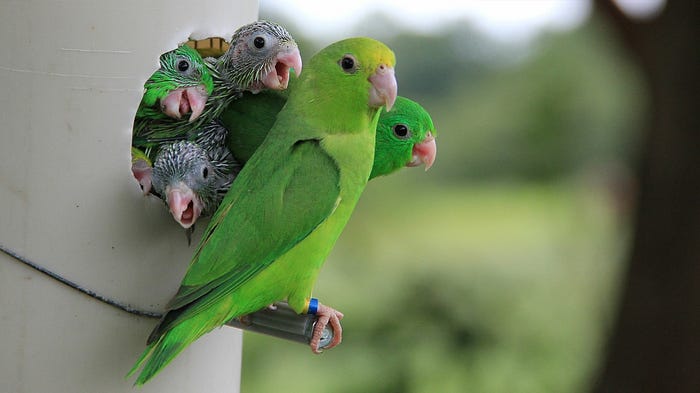Infanticide or Adoption? Unveiling Parrot Behavior in Nature
Written on
Understanding Parrot Dynamics
Parrots exhibit a fascinating dichotomy in their social behaviors, particularly concerning the care and killing of their offspring. While many species, like lions, are notorious for infanticide—where new males eliminate competitors' offspring to secure mating rights—parrots often show contrasting behaviors of adoption. This raises the question: what drives these choices?
In a recent study on green-rumped parrotlets (Forpus passerinus), researchers aimed to shed light on these behaviors. These small, monogamous parrots inhabit regions from northern Venezuela to the Amazon's edge, favoring semi-open areas and even urban parks. Their nesting habits differ from many other parrot species, as they prefer nesting in cavities of fence posts and trees.
Since 1988, ecologist Steven Beissinger and his team have meticulously monitored a population of these parrotlets in Venezuela. Their research combines long-term field studies and advanced ecological modeling to understand these birds' behaviors.

Unraveling Infanticide and Adoption
In the course of their research, Beissinger and his colleagues made a startling discovery: a family of healthy parrotlet chicks mysteriously died in one of their artificial nesting sites. As they observed the nests, they witnessed a male parrotlet entering the nest and exiting with blood on its beak, prompting suspicions of infanticide.
Why would parrotlets resort to killing their neighbors' chicks? According to Beissinger, the driving factors are often linked to competition over nesting sites rather than mating opportunities. In their extensive observations, they found that a staggering 69% of infanticide cases occurred during attempts by non-breeding pairs to usurp breeding pairs from their nests.
"The competition for nesting sites is fierce," Beissinger explained, emphasizing the role of male-skewed sex ratios in these dynamics. Interestingly, while many males did engage in killing, they also exhibited a propensity to adopt orphaned chicks.
Chapter 1: The Complex Motivations Behind Behavior
As the study progressed, it became evident that both infanticide and adoption serve as adaptive strategies in this species. For instance, in cases where a parent was lost, a new partner often adopted the surviving chicks. Adoption didn't hinder the stepparent's reproductive success; in fact, it could enhance their chances of mating with the widowed parent.
Furthermore, males who adopted unrelated chicks tended to achieve earlier breeding ages and comparable lifetime reproductive success to those who committed infanticide. This suggests that adopting can be a strategic move, providing both a new mate and a nesting site.
Adopting Baby Parrot Vs Adult Parrot Pros & Cons
In exploring the nuances of parrot adoption, we can glean insights into the trade-offs of adopting a baby parrot versus an adult. This video illustrates the various considerations and benefits involved in each choice.
Chapter 2: Ecological Factors Influencing Behavior
Beissinger's study also highlighted the evolutionary underpinnings of both behaviors. In non-migratory species like parrotlets, where long-term pair bonds exist, the stakes for adoption are higher compared to migratory birds, which may not benefit from stepparent care due to higher mortality rates and less stable social structures.
Big Brother Eviction Cuckoo Style | Natural World
This video explores the intricate dynamics of cuckoo behavior, drawing parallels to the competitive and cooperative strategies observed in parrot behavior.
In summary, Beissinger’s research reveals that both infanticide and adoption serve essential roles in the reproductive strategies of green-rumped parrotlets. These behaviors, shaped by environmental factors and social structures, underline the complexity of animal behavior and the adaptive strategies developed in response to ecological challenges.